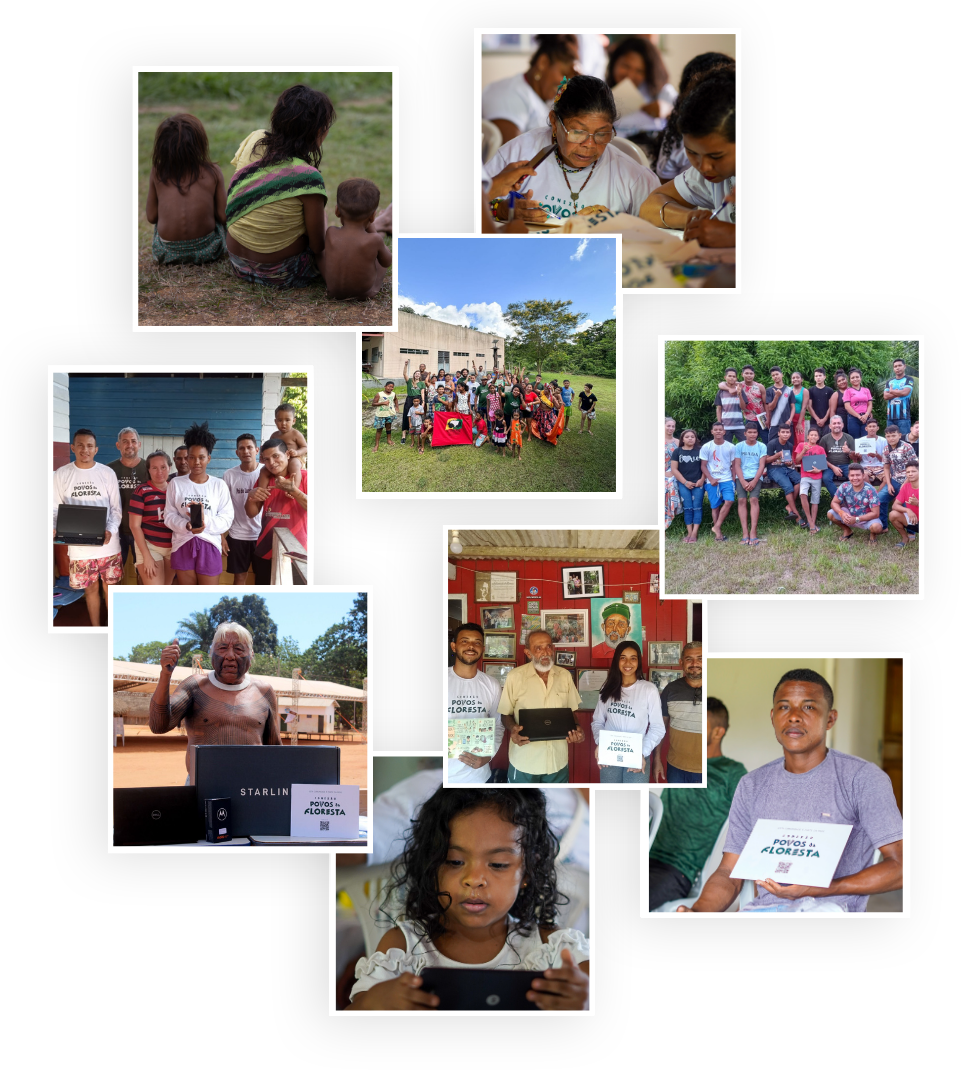
Learn about the project that will bring connection to Amazon!
Conexão Povos da Floresta (‘Forest People Connection’) is a structured network of
partners that aims to guarantee the implementation of a high-speed Internet and the
real effectiveness of the power of technological connection for the forest and all the
peoples that live in protected areas.
connecting…
4537
Quilombola extractivist and indigenous communities.
000
Communities connected to the Povos da Floresta network.
Click to find out more about the Amazon reality and how the high-speed internet connection helps to preserve it.

Indigenous people
Clique para saber mais

Extractivists
Clique para saber mais

Quilombolas
Clique para saber mais
INDIGENOUS PEOPLE
Native peoples of the territory that today is called Latin America, the indigenous are traditional peoples originating from the Brazilian territory. They already amounted to tens of millions before the European invasion and today, in Brazil, there are about 896 thousand inhabitants.
Their social and territorial organizations over physical space do not coincide with the border division between countries, they have an ancient culture and are deeply connected with nature in a relationship of respect, so they are skillful protectors and experts 0 of their territories, maintaining an ancestral and divine relationship, respecting always the forests, the rivers, the plants, and all the beings that live in it. .
They inhabit demarcated territories that are divided by villages and communities, as well as large urban centers and retaken areas, always maintaining their traditions and wisdom, living them in tools of affirmation, resistance and struggle for the right to life. Locally they are guided by leaders, caciques, elders or chiefs, regionally, nationally or internationally they are represented by indigenous organizations or articulations that have indigenous representatives who have been occupying more and more space.
Currently inhabiting 417 indigenous lands effectively homologated with a diversity of 305 different indigenous peoples and mastering 180 0 different languages. Their main demands are the demarcation and protection of their territories, for the right to quality indigenous education and health.
Riverside | EXTRACTIVISTS
Historically known as populations that inhabit the banks of rivers, extractivists and riverside dwellers are today characterized as populations that live both on the banks and floodplains and on high plains throughout Brazil, adapting to seasonal periods of rainfall and water movement.
Its main activity is artisanal fishing and hunting, agriculture with a variety of swiddens and forest extraction with the collection and extraction of fruits, vegetables, seeds and other natural resources.
Their cultures have an immense connection with indigenous, quilombola and Portuguese traditions, bringing together knowledge and ancestral knowledge of these peoples about the forest, rivers, plants and animals and, therefore, they are also considered as guardians of the environment. Another important feature of these peoples is the use and collective management of traditional territories, many of these territories are recognized as Extractive Reserves (Resex), a sustainable development conversation unit (CU).
Due to the geographic aspects of the country, it is in the Amazon that most of this population lives, adding the descendants of migrants from the Northeast of the country, totaling an average of 7,000 riverside and extractive people, according to the Joshua Project.
Quilombolas
Descendants of the ancient ethnic-racial groupings of African nations and formed during slavery and the colonization of Latin America, the Quilombolas are traditional rural or urban black peoples with their own historical trajectories and cultural identities strongly linked to the land, forests, water and the food.
They are characterized by subsistence agriculture and symbolize the essence of the meaning of resistance to different forms of oppression and domination, preserving until today their customs and culture brought by their African ancestors.
In the Bantu language of Angola, the term “kilombo” means landing place or camp and refers to the nomadic habit of West African peoples who used camps as resting places on long journeys and which was later adapted to designate places of refuge for black slaves.
According to the partial balance of the 2022 IBGE Census, the first in 150 years to consider the quilombola population in the survey, these traditional peoples account for more than 386,000 inhabitants spread across 5,972 quilombola locations and 2,308 quilombola groups across all Brazilian regions.

THE PROJECT
BRING HIGH SPEED INTERNET (100mbps) TO ALL FOREST PEOPLE WITHIN 3 YEARS.

THE PROJECT
BRING HIGH SPEED INTERNET (100mbps) TO ALL FOREST PEOPLE WITHIN 3 YEARS.
INCLUSION, SAFETY AND EMPOWERMENT PROGRAMS
Together with technologies for the use and community management of the Internet, an ecosystem of platforms is being developed to strengthen the network between peoples and the best that the Internet can offer as an instrument of social transformation through community demands.
TERRITORIAL MONITORING
Surveillance autonomy for and by forest peoples, guaranteeing their territory.
Health
Telemedicine and remote care, engaging people to stay longer in their territories.
Education
Complementation of educational training with online content available.
Entrepreneurship
Business development thanks to remote communication, via high-speed internet.
CULTURE AND ANCESTRY
Keeping the culture alive for the next generations, increasing the visibility of the traditions of the forest peoples to the world.

GET TO KNOW OUR TECHNOLOGIES
The internet without support is like drifting in the ocean infinity. Our technologies were developed considering the main issues observed by partners and forest communities since the first implementations of projects related to communication and connectivity.
see our maps
Still IN construction.
Here you will be able to visually access the communities inserted in protected territories such as Indigenous Land, Quilombola, Resex, Sustainable Development Reserve (RDS), National Forest (FLONA), State Forest (FLOTA) and Sustainable Development Projects (PDS).
